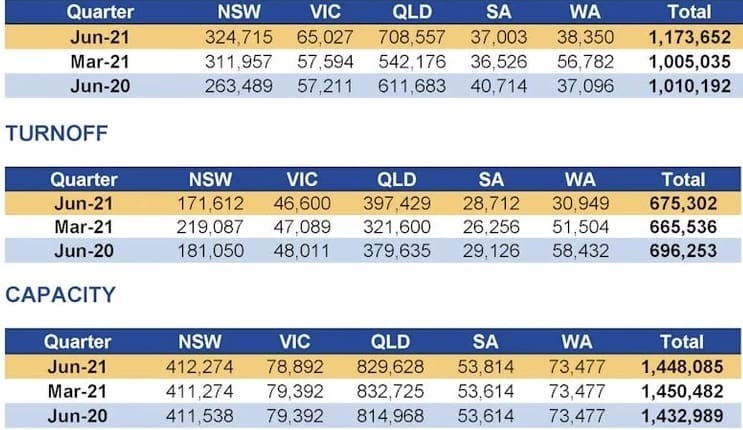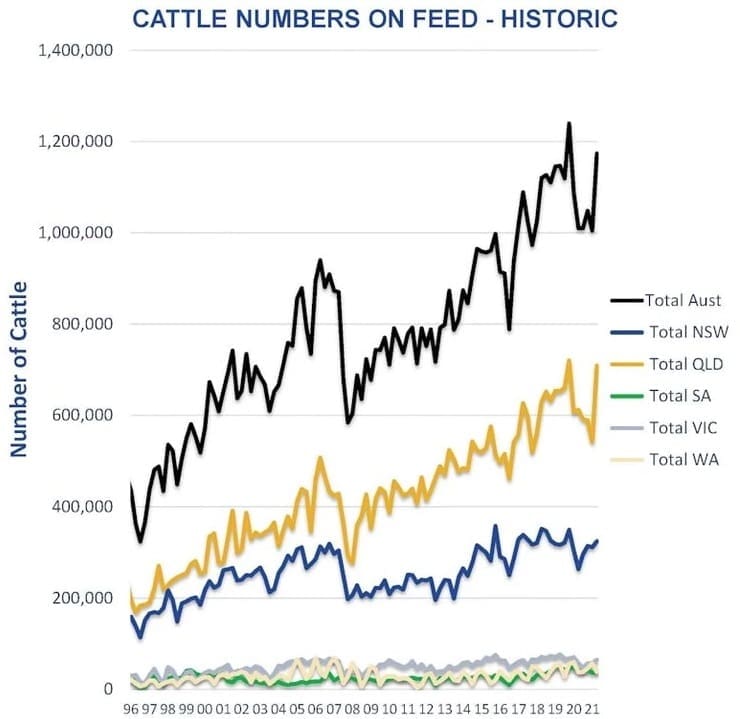THERE has been a surprisingly large surge in cattle on feed across Australian feedlots in the last three months, lifting 17 percent to more than 1.173 million head, results from the June quarter feedlot survey released this morning show.
Numbers on feed across Australia in June jumped by a startling 168,617 head, hitting the second highest number ever recorded. The only larger figure recorded was the record 1.239 million head recorded during the depths of the drought in December quarter 2019.
The quarterly industry survey compiled by Australian Lot Feeders Association and Meat & Livestock Australia showed Queensland accounted for virtually all of the rise, increasing by 166,381 head, or 30.7pc to 708,557 head. Much of this was seen in yards with a capacity of 10,000 head or greater.
New South Wales, Victoria and South Australia recorded modest increases in numbers, with NSW up by 4.1pc or 12,758 head 324,715 head, and Victoria up 7433 head or 12.9pc to 65,027 head. South Australia rose by 1.3pc to 37,003 head, while Western Australia showed its normal seasonal trend, decreasing by 18,432 head or 32.5pc, to 38,350 head.
The size of last quarter’s reported increase took ALFA president Bryce Camm by surprise, he told Beef Central this morning.
“The Queensland rise, in particular, is surprisingly large – particularly in the context of all-time record feeder cattle prices,” Mr Camm said.
He suggested that expensive feeder cattle may be one of the reasons for the trend.
“As young cattle get more and more expensive, as they have this year, then the quicker the owner can finish them and turn them into beef, the better. That, economics-wise, makes sense, and I think that quicker turnover is one of the things that is underpinning lotfeeding operations this year,” Mr Camm said.
“There is good cost-of-gain to be had in the feedyard at the moment, despite some feeder cattle prices being around that 500c/kg mark, liveweight, as they are this week.”
Processors playing part
Equally, though, Mr Camm credited grainfed processors with attempting to ‘keep pace’ with higher feeder costs, with their slaughter cattle pricing grids.
“The rising trend in grainfed slaughter grids is helping motivate lotfeeders to continue to put these very expensive young cattle on feed,” he said. “That’s being underpinned by sustained global demand for high-quality grainfed beef.”
Current Queensland forward grainfed slaughter grids on 100-day cattle are in the high sevens to low eights range for some flatback HGP-free descriptions – hitting all-time highs. Spot price money is around 78pc, also record high.
Mr Camm said the lift in cattle on feed in the June quarter was reflective of the role the feedlot sector was playing in beef production even during uncertain market conditions.
“In an operating environment disrupted by COVID and influenced heavily by herd rebuilding supply and demand dynamics, the feedlot sector continues to provide production certainty that’s attractive to brand owners and supply chains,” he said.
“The fundamental driver is the desire of supply chains to provide consistent quality and supply to their customers 365 days a year, and feedlots facilitate this by providing production certainly in what is otherwise currently an unpredictable market,” he said.
Market signals
MLA market information manager Steve Bignell said lotfeeders continued to see strong market signals for finished cattle during the quarter.
The Queensland 100-day grainfed steer over-the-hooks indicator continued to trade at elevated levels, averaging 677¢/kg carcase weight in the June quarter, he said.
“These signals continue to drive national feedlot utilisation which increased to 81pc and above the five-year June quarter average of 77pc,” Mr Bignell said.
In the previous March quarter, for the first time in history more than 50pc of Australian beef production and domestic consumption was grainfed.
Mr Bignell said he expected that trend to be reflected in the latest production statistics due out on 20 August.
“In this national herd rebuild, when supply remains tight, feedlots are doing an amazing job at assuring continuity of product, both domestically and globally,” he said.


